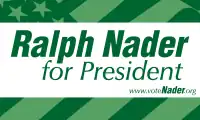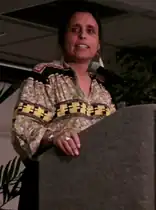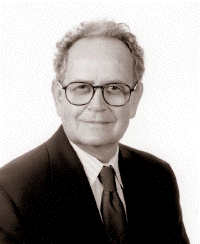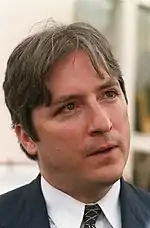Ralph Nader
Ralph Nader (/ˈneɪdər/; born February 27, 1934)[1] is an American perennial presidential candidate, political activist, author, lecturer, and attorney noted for his involvement in consumer protection, environmentalism, and government reform causes. He became famous in the 1960s and 1970s for his book Unsafe at Any Speed, which criticized the automotive industry for its safety record and helped lead to the passage of the National Traffic and Motor Vehicle Safety Act in 1966.
Ralph Nader | |
|---|---|
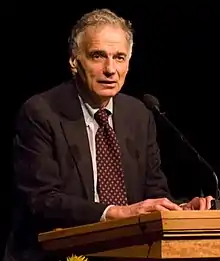 Nader in 2007 | |
| Born | February 27, 1934 Winsted, Connecticut, U.S. |
| Education | Princeton University (AB) Harvard University (LLB) |
| Occupations |
|
| Political party | Green (1996–2000) Reform (2004) Independent (after 2008) |
| Parent |
|
| Relatives |
|
| Awards | |
| Military career | |
| Allegiance | |
| Service/ | |
| Years of service | 1959 |
| Website | Official website |
| Signature | |
 | |
The son of Lebanese immigrants to the United States, Nader attended Princeton University and Harvard Law School. Nader quickly developed an interest in vehicle designs that were hazardous and contributed to elevated levels of car accidents and fatalities.[2] He first came to prominence in 1965 with the publication of the book Unsafe at Any Speed, a highly influential critique of the safety record of American automobile manufacturers focusing on the General Motors' (GM's) Corvair automobile in particular.
Following the publication of Unsafe at Any Speed, Nader led a group of volunteer law students—dubbed "Nader's Raiders"—in an investigation of the Federal Trade Commission, leading directly to that agency's overhaul and reform. In the 1970s, Nader leveraged his growing popularity to establish a number of advocacy and watchdog groups including the Public Interest Research Group, the Center for Auto Safety, and Public Citizen. Two of Nader's most notable targets were the Chevy Corvair and the Ford Pinto.[3]
Nader made four bids to become President of the United States, running with the Green Party in 1996 and 2000, the Reform Party in 2004, and as an independent in 2008. In each campaign, Nader said he sought to highlight under-reported issues and a perceived need for electoral reform. He received nearly three million votes during his 2000 candidacy, but also stirred controversy over allegations that his campaign helped Republican candidate George W. Bush win a close election against Democratic candidate Al Gore.
A two-time Nieman Fellow, Nader is the author or co-author of more than two dozen books and was the subject of a documentary film on his life and work, An Unreasonable Man, which debuted at the 2006 Sundance Film Festival. He has been repeatedly named to lists of the "100 Most Influential Americans", including those published by Life, Time, and The Atlantic. The New York Times described him as a "dissident".[4]
Early life
Ralph Nader was born on February 27, 1934, in Winsted, Connecticut, to Rose (née Bouziane) and Nathra Nader, both of whom were Antiochian Greek Christians immigrants from Mount Lebanon and the Beqaa Valley in Southeastern Lebanon.[5][6][7][8] After settling in Connecticut, Nathra Nader worked in a textile mill before opening a bakery and restaurant.[9] Ralph Nader occasionally helped at his father's restaurant, as well as worked as a newspaper delivery boy for the local paper, the Winsted Register Citizen.[10] Nader graduated from The Gilbert School in 1951, going on to attend Princeton University. Though he was offered a scholarship to Princeton, his father forced him to decline it on the grounds that the family was able to pay Nader's tuition and the funds should go to a student who could not afford it.[11] Nader graduated magna cum laude and Phi Beta Kappa[12] with a Bachelor of Arts from the Woodrow Wilson School of Public and International Affairs in 1955 after completing a senior thesis titled "Lebanese Agriculture".[13][14]
After graduating from Princeton, Nader enrolled at Harvard Law School, though he quickly became bored by his courses. While at Harvard, Nader would frequently skip classes to hitchhike across the U.S. where he would engage in field research on Native American issues and migrant worker rights. He earned a LL.B. from Harvard in 1958.[10] Nader identified with libertarian philosophy in his youth, but gradually shifted away in his early 20s. Although Nader acknowledged that he "didn't like public housing because it disadvantaged landlords unfairly", his viewpoint changed when he "saw the slums and what landlords did".[15] After graduating from Harvard, Nader served in the U.S. Army as a cook and was posted to Fort Dix.[10]
Career
Early history
In 1959, Nader was admitted to the bar and began practice as a lawyer in Hartford, Connecticut, while also lecturing at the University of Hartford and traveling to the Soviet Union, Chile, and Cuba, where he filed dispatches for the Christian Science Monitor and The Nation.[10] In 1964, he moved to Washington, D.C., taking a position as a consultant to Assistant Secretary of Labor Daniel Patrick Moynihan.[16]
Unsafe at Any Speed
Nader was first propelled into the national spotlight with the 1965 publication of his journalistic exposé Unsafe at Any Speed. Though he had previously expressed an interest in issues of automobile safety while a law student, Unsafe at Any Speed presented a critical dissection of the automotive industry by claiming that many American automobiles were generally unsafe to operate. Nader researched case files from more than 100 lawsuits then pending against General Motors' Chevrolet Corvair to support his assertions.[17]
The book became an immediate bestseller, but also prompted a vicious backlash from General Motors (GM) who attempted to discredit Nader by tapping his phone in an attempt to uncover salacious information and, when that failed, hiring prostitutes in an attempt to catch him in a compromising situation.[18][19] Nader, by then working as an unpaid consultant to United States Senator Abe Ribicoff, reported to the senator that he suspected he was being followed. Ribicoff convened an inquiry that called GM CEO James Roche who admitted, when placed under oath, that the company had hired a private detective agency to investigate Nader. Nader sued GM for invasion of privacy, settling the case for $425,000 and using the proceeds to found the activist organization known as the Center for the Study of Responsive Law.[10]
A year following the publication of Unsafe at Any Speed, Congress unanimously enacted the National Traffic and Motor Vehicle Safety Act. Speaker of the United States House of Representatives John William McCormack said the passage of the National Traffic and Motor Vehicle Safety Act was due to the "crusading spirit of one individual who believed he could do something: Ralph Nader".[20]
"Nader's Raiders", Public Citizen and Center for Auto Safety
In 1968, Nader recruited seven volunteer law students, dubbed "Nader's Raiders" by the Washington press corps, to evaluate the efficacy and operation of the Federal Trade Commission (FTC). The group's ensuing report, which criticized the body as "ineffective" and "passive" led to an American Bar Association investigation of the FTC. Based on the results of that second study, Richard Nixon revitalized the agency and sent it on a path of vigorous consumer protection and antitrust enforcement for the rest of the 1970s.[21]
Nader’s Raiders became involved in such issues as nuclear safety, international trade, regulation of insecticides, meat processing, pension reform, land use, and banking.[22]
Following the publication of the report, Nader founded the watchdog group Public Citizen in 1971 to engage in public interest lobbying and activism on issues of consumer rights.[23] He also served on its board of directors until 1980.[24]
1970s–1990s


By the early 1970s Nader had established himself as a household name. In a critical memo written by Lewis Powell to the U.S. Chamber of Commerce, Powell warned business representatives that Nader "has become a legend in his own time and an idol of millions of Americans".[25]
Ralph Nader's name appeared in the press as a potential candidate for president for the first time in 1971, when he was offered the opportunity to run as the presidential candidate for the New Party, a progressive split-off from the Democratic Party. Chief among his advocates was author Gore Vidal, who touted a 1972 Nader presidential campaign in a front-page article in Esquire magazine in 1971.[26] Nader declined the advances.[27][28]
In 1973, Ralph Nader was plaintiff in the case against acting attorney general Robert Bork, who under orders of President Richard Nixon had fired special prosecutor Archibald Cox in the so-called Saturday Night Massacre, an action that was ultimately ruled illegal by federal judge Gerhard Gesell.[29]
In 1974, he received the S. Roger Horchow Award for Greatest Public Service by a Private Citizen.[30]
In the 1970s, Nader turned his attention to environmental activism, becoming a key leader in the antinuclear power movement, described by one observer as the "titular head of opposition to nuclear energy".[31][32] The Critical Mass Energy Project was formed by Nader in 1974 as a national anti-nuclear umbrella group, growing to become the largest national anti-nuclear group in the United States, with several hundred local affiliates and an estimated 200,000 supporters.[33] The organization's main efforts were directed at lobbying activities and providing local groups with scientific and other resources to campaign against nuclear power.[34][28]: 172–179
Throughout the 1970s and 1980s, through his ongoing work with Public Citizen, Nader continued to be involved in issues of consumer rights and public accountability. His work testifying before Congress, drafting model legislation, and organizing citizen letter-writing and protest efforts, earned him direct credit for the enactment of the Freedom of Information Act, Foreign Corrupt Practices Act, Clean Water Act, Consumer Product Safety Act, and Whistleblower Protection Act.[35][36][37][38]
In the late 1990s, Nader would accuse Microsoft of being a monopoly. He would organize a conference featuring Microsoft's critics from the tech world.[39]
In 1999, Nader was unsuccessfully approached by Nike to appear in an advertisement. The firm offered Nader $25,000 to say "another shameless attempt by Nike to sell shoes" while holding Air 120 sneakers. After Nader turned down the offer, the corporation hired filmmaker Spike Lee.[40]
1972

Ralph Nader's name appeared in the press as a potential candidate for president for the first time in 1971, when he was offered the opportunity to run as the presidential candidate for the New Party, a progressive split-off from the Democratic Party in 1972. Chief among his advocates was author Gore Vidal, who touted a 1972 Nader presidential campaign in a front-page article in Esquire magazine in 1971.[26] Psychologist Alan Rockway organized a "draft Ralph Nader for President" campaign in Florida on the New Party's behalf.[41] Nader declined their offer to run that year; the New Party ultimately joined with the People's Party in running Benjamin Spock in the 1972 presidential election.[27][28][42] Spock had hoped Nader in particular would run, getting "some of the loudest applause of the evening" when mentioning him at the University of Alabama.[43] Spock went on to try to recruit Nader for the party among over 100 others, and indicated he would be "delighted" to be replaced by any of them even after he accepted the nomination himself.[44] Nader received one vote for the vice-presidential nomination at the 1972 Democratic National Convention.[45]
1980
In the 1980 Presidential Election, the progressive-oriented Citizens Party approached Nader with the prospect of running as their Presidential Nominee. Nader declined their offer stating "I will never run for president".[46] The party ended up nominating biologist Barry Commoner instead.[47]
1992
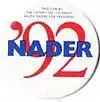
Nader stood in as a write-in for "none of the above" in both the 1992 New Hampshire Democratic and Republican Primaries[48] and received 3,054 of the 170,333 Democratic votes and 3,258 of the 177,970 Republican votes cast.[49] He was also a candidate in the 1992 Massachusetts Democratic Primary.[50]
1996
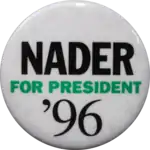
Nader was drafted as a candidate for President of the United States on the Green Party ticket during the 1996 presidential election. He was not formally nominated by the Green Party USA, which was, at the time, the largest national Green group; instead he was nominated independently by various state Green parties (in some states, he appeared on the ballot as an independent). However, many activists in the Green Party USA worked actively to campaign for Nader that year. Nader qualified for ballot status in 22 states,[51] garnering 685,297 votes or 0.71% of the popular vote (fourth place overall),[52] although the effort did make significant organizational gains for the party. He refused to raise or spend more than $5,000 on his campaign,[53] presumably to avoid meeting the threshold for Federal Elections Commission reporting requirements.[54] The unofficial Draft Nader committee could (and did) spend more than that, but the committee was legally prevented from coordinating in any way with Nader himself.
Nader received some criticism from gay rights supporters for calling gay rights "gonadal politics" and stating that he was not interested in dealing with such matters.[55] In July 2004, however, he publicly stated that he supported same-sex marriage.[56]
His 1996 running mates included: Anne Goeke (nine states), Deborah Howes (Oregon), Muriel Tillinghast (New York), Krista Paradise (Colorado), Madelyn Hoffman (New Jersey), Bill Boteler (Washington, D.C.), and Winona LaDuke (California and Texas).[57]
2000
In the 2006 documentary An Unreasonable Man, Nader describes how he was unable to get the views of his public interest groups heard in Washington, even by the Clinton Administration. Nader cites this as one of the primary reasons that he decided to actively run in the 2000 election as candidate of the Green Party, which had been formed in the wake of his 1996 campaign.
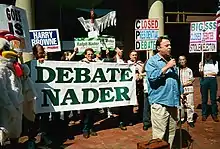
In June 2000, The Association of State Green Parties (ASGP) organized the national nominating convention that took place in Denver, Colorado, at which Green Party delegates nominated Ralph Nader and Winona LaDuke to be their party's candidates for president and vice president.[58][59]
On July 9, the Vermont Progressive Party nominated Nader, giving him ballot access in the state.[60] On August 12, the United Citizens Party of South Carolina chose Ralph Nader as its presidential nominee, giving him a ballot line in the state.[61]
In October 2000, at the largest Super Rally of his campaign,[62] held in New York City's Madison Square Garden, 15,000 people paid $20 each[63] to hear Nader speak. Nader's campaign rejected both parties as institutions dominated by corporate interests, stating that Al Gore and George W. Bush were "Tweedledee and Tweedledum". A long list of notable celebrities spoke and performed at the event including Susan Sarandon, Ani DiFranco, Ben Harper, Tim Robbins, Michael Moore, Eddie Vedder and Patti Smith. The campaign also had some prominent union help: The California Nurses Association and the United Electrical Workers endorsed his candidacy and campaigned for him.[64]
Nader and LaDuke received 2,883,105 votes, for 2.74 percent of the popular vote (third place overall),[65] missing the 5 percent needed to qualify the Green Party for federally distributed public funding in the next election, yet qualifying the party for ballot status in many states.
Nader often openly expressed his hope for Bush's victory over Gore, saying it "would mobilize us",[66] and that environmental and consumer regulatory agencies would fare better under Bush than Gore.[67] When asked which of the two he'd vote for if forced, Nader answered "Bush ... If you want the parties to diverge from one another, have Bush win."[68] As to whether he would feel regret if he caused Gore's defeat, Nader replied "I would not—not at all. I'd rather have a provocateur than an anesthetizer in the White House."[69] On another occasion, Nader answered this question with: "No, not at all ... There may be a cold shower for four years that would help the Democratic Party ... It doesn't matter who is in the White House."[67]
Spoiler controversy
In the 2000 presidential election in Florida, George W. Bush defeated Al Gore by 537 votes. Nader received 97,421 votes, which led to claims that he was responsible for Gore's defeat. Nader disputes that he helped Bush win.[70][71][72] A 2003 study found that Nader's candidacy was a critical factor in Bush's victory.[73] A 2004 study found that Nader voters had the profile of likely voters with a preference for Democratic candidates.[74] They were therefore likely to vote for Gore over Bush in the absence of Nader's candidacy.[74]
A study by Harvard Professor B.C. Burden in 2005 showed Nader did "play a pivotal role in determining who would become president following the 2000 election", but that:
Contrary to Democrats' complaints, Nader was not intentionally trying to throw the election. A spoiler strategy would have caused him to focus disproportionately on the most competitive states and markets with the hopes of being a key player in the outcome. There is no evidence that his appearances responded to closeness. He did, apparently, pursue voter support, however, in a quest to receive 5% of the popular vote.[75]
However, Jonathan Chait of The American Prospect and The New Republic notes that Nader did indeed focus on swing states disproportionately during the waning days of the campaign, and by doing so jeopardized his own chances of achieving the 5% of the vote he was aiming for.
Then there was the debate within the Nader campaign over where to travel in the waning days of the campaign. Some Nader advisers urged him to spend his time in uncontested states such as New York and California. These states – where liberals and leftists could entertain the thought of voting Nader without fear of aiding Bush – offered the richest harvest of potential votes. But, Martin writes, Nader – who emerges from this account as the house radical of his own campaign – insisted on spending the final days of the campaign on a whirlwind tour of battleground states such as Pennsylvania and Florida. In other words, he chose to go where the votes were scarcest, jeopardizing his own chances of winning 5 percent of the vote, which he needed to gain federal funds in 2004.[76]
When Nader, in a letter to environmentalists, attacked Gore for "his role as broker of environmental voters for corporate cash," and "the prototype for the bankable, Green corporate politician," and what he called a string of broken promises to the environmental movement, Sierra Club president Carl Pope sent an open letter to Nader, dated October 27, 2000, defending Al Gore's environmental record and calling Nader's strategy "irresponsible."[77] He wrote:
You have also broken your word to your followers who signed the petitions that got you on the ballot in many states. You pledged you would not campaign as a spoiler and would avoid the swing states. Your recent campaign rhetoric and campaign schedule make it clear that you have broken this pledge ... Please accept that I, and the overwhelming majority of the environmental movement in this country, genuinely believe that your strategy is flawed, dangerous and reckless.[78]
2004
Nader announced on December 24, 2003, that he would not seek the Green Party's nomination for president in 2004, but did not rule out running as an independent candidate.
Ralph Nader and Democratic candidate John Kerry held a widely publicized meeting early in the 2004 presidential campaign. Nader said that John Kerry wanted to work to win Nader's support and the support of Nader's voters, prompting Nader to provide Kerry more than 20 pages of issues that he felt were important. According to Nader, he asked John Kerry to choose any three of the issues and highlight them in his campaign; should Kerry meet these conditions Nader would not contest the election. On February 22, 2004, having not heard back from Kerry, Nader announced that he would run for president as an independent.
Due to concerns about a possible spoiler effect, many Democrats urged Nader to abandon his 2004 candidacy. Terry McAuliffe stated that Nader had a "distinguished career, fighting for working families", and that McAuliffe "would hate to see part of his legacy being that he got us eight years of George Bush". Theresa Amato, Nader's national campaign manager in 2000 and 2004, later alleged that McAuliffe offered to pay-off Nader if he would not campaign in certain states, an allegation confirmed by Nader and undisputed by McAuliffe.[79]
Nader received 463,655 votes, for 0.38 percent of the popular vote, placing him in third place overall.[80]
2008
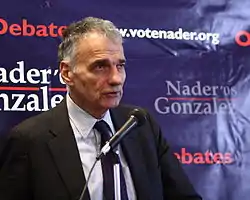
In February 2007, Nader criticized Democratic front-runner Hillary Clinton as "a panderer and a flatterer," later describing her as someone who had "no political fortitude."[81] During a February 2008 appearance on Meet the Press, Nader announced his intention to run for president as an independent, later naming Matt Gonzalez as his running-mate.[82] Nader was endorsed by Howard Zinn, Jesse Ventura, Justin Jeffre, Tom Morello, Val Kilmer, Rocky Anderson, James Abourezk, Patti Smith, and Jello Biafra. The Nader campaign raised $4.3 million in campaign funds, primarily from small, individual donations. Nader/Gonzalez earned 738,475 votes and a third-place finish in the 2008 United States presidential election.[83]
Congressional Accountability Project
Nader founded the Congressional Accountability Project to "oppose corruption in the U. S. Congress."[85]
Later activities
Nader condemned the 2011 military intervention in Libya.[86] He branded President Barack Obama as a "war criminal"[87] and called for his impeachment.[88]
In June 2019, Nader, who lost his 24-year-old grandniece in the Ethiopian Airlines crash,[89] claimed that the Boeing 737 Max "must never fly again... it's not a matter of software. It's a matter of structural design defect: the plane's engines are too much for the traditional fuselage".[90] Nader also called for Boeing top leaders to resign and said that the Federal Aviation Administration "has been in the pockets of the Boeing company for years".[90][91]
D.C. Library Renaissance Project
In 2002, Nader founded the D.C. Library Renaissance Project, which has sought to halt the development of the West End Library in Washington, D.C., alleging that it "violated affordable housing guidelines, undervalued the land, and didn't conform to the city's Comprehensive Plan."[92] The legal obstacles presented by the Library Renaissance Project have cost the D.C. government over one million dollars in legal fees.[93] Nader has opposed the privatized development of D.C. libraries despite community support, citing a lack of oversight and competitive bidding process.[94]
Only the Super Rich Can Save Us
In 2009 Nader published his first work of fiction, Only the Super-Rich Can Save Us!. Many of the characters were fictionalized versions of real-life persons including Ted Turner and Warren Buffett. The book's principal villain, a "conservative evil genius" named Brovar Dortwist, represents Grover Norquist. According to Norquist, Nader had called him prior to the book's publication and said he "wouldn't be too unhappy, because the character was principled".[95]
The novel met with mixed reviews with The Wall Street Journal noting that the book "reads less like a novel ... than a dream journal" with a plot that victoriously concludes with "American society thoroughly Naderized", though The Globe and Mail called it "a powerful idea by the perfect person at a fortuitous time".[96][97]
Nader also branched out into fiction with the fable collection Animal Envy in 2016.[98]
2012 debate moderator
During the 2012 United States presidential election, Nader moderated a debate for third-party candidates at Washington, D.C.'s Busboys and Poets. The debate was attended by Green Party presidential candidate Jill Stein, Libertarian Gary Johnson, Rocky Anderson of the Justice Party and Constitution Party candidate Virgil Goode. He later moderated a similar debate in a studio appearance broadcast by Russia Today.[99]
Ralph Nader Radio Hour
Since March 2014, Nader has co-hosted the weekly Ralph Nader Radio Hour,[100] produced at KPFK-FM in Los Angeles and distributed via the Pacifica Radio Network. The program features "interviews with some of the nation's most influential movers and shakers" and discussion of current events. Nader's co-hosts are Steve Skrovan and David Feldman.[101]
American Museum of Tort Law
In 2015, after a decade planning, Nader founded the American Museum of Tort Law in Winsted, Connecticut. The opening ceremonies were emceed by Phil Donahue. Nader personally donated $150,000 to the establishment of the museum, which was sited on two parcels of land rezoned by the town of Winsted to host it. At the time of its opening, some expressed skepticism that a museum dedicated to tort would have much interest to the general public, though Nader responded that he was "astounded how a country can go over 200 years and not have a law museum".[102]
Campaign for Harvard admissions reform
Nader unsuccessfully sought a seat on the Harvard University Board of Overseers in 2016 as part of an insurgent candidate slate operating under the name "Free Harvard, Fair Harvard" which called for increased transparency by the university as to how it made athletic and legacy admissions decisions.[103] In February of that year, while noting that he would not vote for him personally, he expressed support for Donald Trump making a third-party run for president, saying that such a move might help break-up the two party system.[104]
Newspapers
In 2022, Nader founded the Capitol Hill Citizen and the Winsted Citizen.[105][106]
Personal life
Nader, whose family was Antiochian Greek Orthodox Christian, recalled that during his childhood his family had been "embraced" by a Methodist church where he attended Sunday school.[107] In addition to English, Nader also speaks Spanish, Russian, Portuguese, Chinese, and conversational Arabic.[108][109]
Nader defines his ideology not as left-wing or right-wing but as a "moral empiricist".[110] He has lived in Washington D.C. since the 1960s, but is domiciled in Connecticut, where he is registered to vote.[93]
His siblings are Laura (a professor of social and cultural anthropology at U.C. Berkeley), Claire, and late brother Shafeek.[8] After his older brother Shafeek died of prostate cancer in 1986, Nader developed Bell's palsy, which paralyzed the left side of his mouth for several months. He commented on his partial facial paralysis to audiences during this time with the quip that "at least my opponents can't say I'm talking out of both sides of my mouth."[111][112] Nader's grandniece Samya Stumo was among the 157 people killed in the crash of Ethiopian Airlines Flight 302 in March 2019.[89]
Nader is a lifelong fan of the New York Yankees.[113]
Personality and character traits
Nader has been described as an "ascetic ... bordering on self-righteous".[114] Despite access to respectable financial assets, he famously lives in a modest apartment and spends $25,000 on personal bills, conducting most of his writing on a typewriter.[115][116] According to popular accounts of his personal life, he does not own a television, relies primarily on public transportation, and over a 25-year period, until 1983, exclusively wore one of a dozen pairs of shoes he had purchased at a clearance sale in 1959. His suits, which he reports he purchases at sales and outlet stores, have been the repeated subject of public scrutiny, being variously described as "wrinkled", "rumpled", and "styleless". A newspaper story once described Nader as a "conscientious objector to fashion".[117]
Nader has never married. Karen Croft, a writer who worked for Nader in the late 1970s at the Center for Study of Responsive Law, once asked him if he had ever considered marriage, to which he reportedly responded that he had made a choice to dedicate his life to career rather than family.[118]
Finances
According to the mandatory fiscal disclosure report that he filed with the Federal Election Commission in 2000, Nader owned more than $3 million worth of stocks and mutual fund shares; his single largest holding was more than $1 million worth of stock in Cisco Systems, Inc. He also held between $100,000 and $250,000 worth of shares in the Magellan Fund.[119] Nader said he owned no car and owned no real estate directly in 2000, and said that he lived on $25,000 a year, giving most of his stock earnings to many of the over four dozen non-profit organizations he had founded.[120][121]
Nader owns shares in Amazon and believes the corporation should be paying shareholders a dividend.[122] He also believes that there should be an "antitrust investigation" looking into the company's business practices.[123]
Nader is also an Apple Inc. shareholder. In 2018, he wrote an open letter to Tim Cook criticizing Apple's $100 billion share buyback.[124]
Media appearances
Film
In the 2005 Jim Carrey film Fun with Dick and Jane, Nader makes a cameo appearance as himself.[125]
The Steve Skrovan documentary film An Unreasonable Man is about the life of Ralph Nader and uses both archival footage and original interviews. It debuted at the Sundance Film Festival in 2006.[126]
Periodicals
Nader was featured on the cover of the January 22, 1968, issue of Newsweek; the December 12, 1969, issue of Time; the June 1971 issue of Esquire; and the August 2016 issue of Pacific Standard.
Television
Nader has been a guest on multiple episodes of Saturday Night Live, Real Time with Bill Maher, The Daily Show, The O'Reilly Factor, Meet the Press, Democracy Now!, and The Late Show with David Letterman. In 2003 he appeared on Da Ali G Show[127] and, in 2008, was interviewed by Triumph the Insult Comic Dog on Late Night with Conan O'Brien.[128]
In 1988, Nader appeared on Sesame Street as "a person in your neighborhood", the episode also featuring Barbara Walters and Martina Navratilova. Nader's appearance on the show was memorable because it was the only time that the grammar of the last line of the song – "a person that you meet each day" – was questioned and changed. Nader refused to sing a line which he deemed grammatically improper, so a compromise was reached by which Nader sang the last line solo, with the modified words: "a person whom you meet each day."[129]
Bibliography
Recognition

- In 1967 Nader was named one of the "Ten Outstanding Young Men of the Year" by the United States Junior Chamber.[130]
- In 1990 Nader was listed one of the "100 Most Influential Americans of the 20th century by Life magazine.[131]
- In 1999 Time magazine named Nader one of the "100 Most Influential Americans of the 20th Century".[132]
- In 1999 a New York University panel of journalists ranked Unsafe at Any Speed 38th among the top 100 pieces of journalism of the 20th century.[133]
- In 2006 Nader was named one of the "100 Most Influential Americans" by The Atlantic.[134]
- In 2008 Nader was listed among the "100 Most Influential Americans" in the Britannica Guide to 100 Most Influential Americans.[135]
- In 2016 Nader was inducted into the Automotive Hall of Fame.[136]
- In 2016 Nader received that year's Gandhi Peace Award from Promoting Enduring Peace.[137]
Electoral history
| Party | Candidate | Votes | % | |
|---|---|---|---|---|
| Democratic | Bill Clinton/Al Gore | 47,401,185 | 49.2% | |
| Republican | Bob Dole/Jack Kemp | 39,197,469 | 40.7% | |
| Reform | Ross Perot/Pat Choate | 8,085,294 | 8.4% | |
| Green | Ralph Nader/Winona LaDuke | 685,297 | 0.7% | |
| Party | Candidate | Votes | % | |
|---|---|---|---|---|
| Republican | George W. Bush/Dick Cheney | 50,456,002 | 47.9% | |
| Democratic | Al Gore/Joe Lieberman | 50,999,897 | 48.4% | |
| Green | Ralph Nader/Winona LaDuke | 2,882,955 | 2.7% | |
| Party | Candidate | Votes | % | |
|---|---|---|---|---|
| Republican | George W. Bush/Dick Cheney | 62,040,610 | 50.7% | |
| Democratic | John Kerry/John Edwards | 59,028,444 | 48.3% | |
| Reform | Ralph Nader/Peter Camejo | 465,151 | 0.4% | |
| Party | Candidate | Votes | % | |
|---|---|---|---|---|
| Democratic | Barack Obama/Joe Biden | 69,498,516 | 52.9% | |
| Republican | John McCain/Sarah Palin | 59,948,323 | 45.7% | |
| Independent | Ralph Nader/Matt Gonzalez | 739,034 | 0.6% | |
See also
- The Case Against Free Trade
- Corporate welfare, a term coined by Nader
References
- "Ralph Nader Biography and Interview". www.achievement.org. American Academy of Achievement.
- "Ralph Nader | Biography, Unsafe at Any Speed, & Facts | Britannica". www.britannica.com. September 29, 2023. Retrieved September 30, 2023.
- "Ralph Nader's new museum is a monument to beating corporations in the courtroom". October 28, 2015.
- Weaver, Warren, Jr. (January 26, 1972). "A Dozen Dissidents Criticize the President and the Government in 'the People's State of the Union'". The New York Times.
{{cite news}}: CS1 maint: multiple names: authors list (link) - "Pastor Bassilios Nadar "Nader" Saffi (March 2018)" (PDF). Antiochian Greek Orthodox Church of America. Retrieved December 18, 2022.
- "Nader a Winner This Day – Ralph Nader". Washington Times. March 18, 2002.
- Graham, Kevin (2000), Ralph Nader : Battling for Democracy, Denver, Colorado: Windom Publishing Company, ISBN 0-9700323-0-7
- Annie Birdsong (August 13, 2000). "Ralph Nader's Childhood Roots". Green Party of Ohio (official website). Green Party of Ohio. Archived from the original on August 16, 2000. Retrieved May 20, 2014.
- Mantel, Henriette (Director) (2006). An Unreasonable Man (DVD). IFC Films.
- Green, Mark (December 1, 2015). "How Ralph Nader Changed America". The Nation. Retrieved August 2, 2016.
- Nancy Bowen (April 1, 2002). Ralph Nader: Man With a Mission. Millbrook Press. ISBN 9780761323655.
- "Nader, Ralph". West's Encyclopedia of American Law. 2005. Retrieved March 15, 2019 – via Encyclopedia.com.
- "Ralph Nader Biography". Biography. May 10, 2016. Retrieved October 4, 2019.
- Nader, Ralph (1955). Lebanese Agriculture (Thesis). Princeton University, Department of Politics.
- "Ralph Nader, "To The Ramparts"". Politics and Prose. Tom Warren. Archived from the original on October 30, 2021. Retrieved October 4, 2018.
- Marcello, Patricia Cronin (2004). Ralph Nader: A Biography. Westport, CT: Greenwood Press. p. 15. ISBN 0313330042. Retrieved January 27, 2017.
Moynihan.
- Mickey Z (2005). 50 American Revolutions You're Not Supposed to Know. New York: The Disinformation Company. p. 87. ISBN 1-932857-18-4.
- "Ralph Nader's museum of tort law will include relics from famous lawsuits—if it ever gets built". LegalAffairs.org. December 2005.
- "President Dwight D. Eisenhower and the Federal Role in Highway Safety: Epilogue — The Changing Federal Role". Federal Highway Administration. May 7, 2005.
- "Congress Acts on Traffic and Auto Safety". CQ Almanac. Congressional Quarterly. 1966. pp. 266–268. Retrieved April 27, 2016.
Breaking into the traffic safety inertia was the publication in November 1965 of Unsafe At Any Speed, a book written by Ralph Nader a 32-year-old Connecticut lawyer who had served as a consultant for the Department of Labor and a Senate subcommittee in 1964–65. House Speaker John W. McCormack (D Mass.) Oct. 21, 1966, credited the final outcome of the traffic safety bill to the 'crusading spirit of one individual who believed he could do something: Ralph Nader'.
- Niesen, Molly. "The Little Old Lady Has Teeth: The U.S. Federal Trade Commission and the Advertising Industry, 1970–1973". Advertising & Society Review 12.4. Retrieved July 19, 2012.
- "Ralph Nader | Biography, Unsafe at Any Speed, & Facts | Britannica". www.britannica.com. September 29, 2023. Retrieved September 30, 2023.
- "NADER FORMS UNIT TO SEEK DONATIONS". The New York Times. June 2, 1971. ISSN 0362-4331. Retrieved July 18, 2023.
- "Nader Resigns as Chief Of Public Citizen Inc". The New York Times. November 2, 1980. ISSN 0362-4331. Retrieved July 18, 2023.
- "The Lewis Powell Memo – A Corporate Blueprint to Dominate Democracy". Greenpeace. Retrieved January 1, 2014.
- Vidal, Gore (May 13, 2008). "The Best Man/'72". Esquire. Archived from the original on January 5, 2010.
- Barnes, Peter. "Toward '72 and Beyond: Starting a Fourth Party". The New Republic. No. July 24–31, 1971. pp. 9–21.
- Martin, Justin (2002). Nader: Crusader, Spoiler, Icon. Cambridge, MA: Perseus Publishing. ISBN 0-7382-0563-X.
- Nader v. Bork, 366 F. Supp. 104 (D.D.C. 1973)
- "Jefferson Awards FoundationNational - Jefferson Awards Foundation". Jefferson Awards Foundation. Archived from the original on November 24, 2010. Retrieved January 15, 2016.
- Nuclear Power in an Age of Uncertainty (PDF) (Report). Washington, D.C.: U.S. Congress, Office of Technology Assessment. February 1984. p. 228. OTA-E-216.
- Kasperson, Roger E.; Berk, Gerald; Pijawka, David; Sharaf, Alan B.; Wood, James (1980). "Public Opposition to Nuclear Energy: Retrospect and Prospect". Science, Technology, & Human Values. 5 (31): 11–23. doi:10.1177/016224398000500203. JSTOR 689009. S2CID 145616169.
- Cohn, Steve (1997). Too cheap to meter: an economic and philosophical analysis of the nuclear dream. SUNY Press. pp. 133–134. ISBN 9780791433898.
- Wolfgang Rudig (1990). Anti-nuclear Movements: A World Survey of Opposition to Nuclear Energy, Longman, p. 402.
- McCraw, David E. "The "Freedom From Information" Act: A Look Back at Nader, FOIA, and What Went Wrong". www.yalelawjournal.org. Retrieved September 20, 2023.
- Kelly, Michael. "Celebrating THE Clean Water Champion". Clean Water Action. Retrieved September 20, 2023.
- Staff, W. N. N. (December 1, 2021). "'An Unheard of Dream': Ralph Nader's 50 Years in Whistleblowing". Whistleblower Network News. Retrieved September 20, 2023.
- "How Ralph Nader defined consumer rights". PBS Newshour Classroom. Retrieved September 20, 2023.
- Heilemann, John. "The Truth, The Whole Truth, and Nothing But The Truth". Wired. Retrieved April 14, 2018.
- "Nader Nixes Nike $25K Run". The Washington Post. May 13, 1999. Retrieved December 8, 2018.
- "Coalition Party Opens Conference". Spartanburg Herald-Journal. October 2, 1971. pp. 2A.
- Gore Vidal. "The Best Man /'72: Ralph Nader Can Be President of the US." Esquire, June 1971.
- Smithey, Waylon (September 23, 1971). "Spock Shares Youths' Views". The Tuscaloosa News. p. 2.
- "People's Party Nominates Dr. Spock for President". Spartanburg Herald-Journal. November 29, 1971. pp. B5.
- "Our Campaigns - US Vice President - D Convention Race - Jul 10, 1972".
- "The Shocking Campaign Ad That Put a Third-Party Candidate on the Political Map".
- Vinciguerra, Thomas (June 19, 2007). "A Conversation with Barry Commoner: At 90, an Environmentalist From the '70s Still Has Hope". The New York Times. Retrieved October 2, 2012.
- "The 1992 Campaign: Write-In; In Nader's Campaign, White House Isn't the Goal". The New York Times. February 18, 1992.
- "1992 Presidential Primary". Sos.nh.gov. February 18, 1992. Archived from the original on July 16, 2009. Retrieved May 24, 2010.
- "PD43+ » 1992 President Democratic Primary Statewide (showing only Dukes County)". PD43+. Retrieved July 18, 2023.
- "Politics1.com". Politics1.com. February 27, 1934. Archived from the original on March 16, 2008. Retrieved May 24, 2010.
- "Uselectionatlas.org". Uselectionatlas.org. Retrieved May 24, 2010.
- Jr, B. Drummond Ayres (August 20, 1996). "Ralph Nader Is Nominated for President, but Vows He Will Ignore His Party's Platform". The New York Times. ISSN 0362-4331. Retrieved July 18, 2023.
- "Candidate Nader runs quixotic campaign Unconventional effort has minimal budget and low expectations; CAMPAIGN 1996". Baltimore Sun. September 23, 1996. Retrieved July 18, 2023.
- "1.75 cheers for Ralph". Left Business Observer. October 1996. Retrieved May 24, 2010.
- "On The Issues". Votenader.org. September 9, 2018. Retrieved October 4, 2019.
- Gaard, Greta (May 11, 1998). Ecological Politics: Ecofeminists and the Greens, Temple University Press. page 240.
- "Green Meeting Will Establish Greens as a National Party". Common Dreams Progressive Newswire. July 11, 2001. Archived from the original on December 8, 2013. Retrieved August 28, 2009.
- Nelson, Susan. "The G/GPUSA Congress and the ASGP Conference: Authentic Grassroots Democracy vs. Packaged Public Relations". Synthesis/Regeneration. Retrieved August 28, 2009.
- Ballot Access News (August 1, 2000). "Vermont Progressives Nominate Nader". Archived from the original on October 22, 2002. Retrieved October 22, 2002.
- (2000-08-01) "United Citizens Party Picks Nader". Archived from the original on August 20, 2002. Retrieved August 20, 2002., Ballot Access News.
- "Nader 'Super Rally' Draws 12,000 To Boston's FleetCenter". Commondreams.org. Archived from the original on April 18, 2010. Retrieved May 24, 2010.
- "Loyal Nader fans pack Madison Square Garden". CNN. October 14, 2000. Archived from the original on December 2, 2008.
- "Nader, the Greens and 2008". Socialistworker.org. January 25, 2008. Archived from the original on December 4, 2008. Retrieved May 24, 2010.
- David Leip. "2000 Presidential General Election Results". Retrieved January 15, 2016.
- Calvo, Dana (October 21, 2000). "Nader Refuses to Cease Fire on Gore, Bush". Los Angeles Times. Retrieved September 19, 2016.
- "Transcript: Ralph Nader on 'Meet The Press'". Common Dreams. August 6, 2000. Archived from the original on November 12, 2016.
- Heinrichs, Jay (August 1, 2000). "Will Ralph Nader become Al Gore's worst nightmare?". Outside Magazine.
- Poundstone, William (February 17, 2009). Gaming the Vote: Why Elections Aren't Fair (and What We Can Do About It). Macmillan. p. 84. ISBN 9780809048922.
- "Dear Conservatives Upset With the Policies of the Bush Administration". Nader for President 2004. Archived from the original on July 2, 2004.
- Varadarajan, Tunku (May 31, 2008). "Interview: Ralph Nader". The Wall Street Journal.
- "Nader on the Record". Grist. March 19, 2008.
- Magee, Christopher S. P. (September 2003). "Third-Party Candidates and the 2000 Presidential Election". Social Science Quarterly. 84 (3): 574–595. doi:10.1111/1540-6237.8403006.
- Southwell, Priscilla L (September 1, 2004). "Nader voters in the 2000 Presidential Election: what would they have done without him?". The Social Science Journal. 41 (3): 423–431. doi:10.1016/j.soscij.2004.04.009. S2CID 144552793.
- Burden, B. C. (September 2005). "Ralph Nader's Campaign Strategy" (PDF). American Politics Research: 673–699. Archived from the original (PDF) on July 13, 2011.
- "Books in Review: | The American Prospect". Prospect.org. Archived from the original on December 22, 2010. Retrieved January 1, 2011.
- "The Nader Debate with the Sierra Club about Gore and the Environment". knowthecandidates.org.
- Pope, Carl (October 27, 2000). "Ralph Nader Attack On Environmentalists Who Are Supporting Vice-President Gore". CommonDreams.org. Archived from the original on November 12, 2016.
- Kumar, Anita; Helderman, Rosalind S. (May 29, 2009). "Nader: McAuliffe Offered Money To Avoid Key States in '04 Race". The Washington Post. Retrieved May 24, 2010.
- "2004 Presidential General Election Results". Dave Leip's Atlas of U.S. Presidential Elections. Retrieved February 24, 2009.
- Nichols, John (January 31, 2008). "An Unreasonable Man May Run Again".
- "Nader names running mate in presidential bid". CBC News. February 28, 2008. Retrieved October 30, 2008.
- "2008 Official Presidential General Election Results" (PDF). FEC. November 4, 2008. Retrieved February 3, 2009.
- "Ralph Nader Candidate Summary, 2008 Cycle". opensecrets.org. OpenSecrets. Retrieved August 1, 2016.
- per 1993-2007 director Gary Ruskin's formal wording: "Its mission is to ... "Application for Member, Delegation to Green Party of the United States". February 28, 2011.
- McMaster, Nick (March 21, 2011). "Ralph Nader: Impeach 'War Criminal' Obama – If Bush, Cheney Were Criminals, Obama Is Too". Newser. Retrieved April 23, 2011.
- Avlon, John P. (March 23, 2011). "Left's View on Libya: Is This Bush's Third Term?". CNN. Retrieved April 23, 2011.
- O'Reilly, Bill (March 27, 2011). "A Noble Fight in Libya". Boston Herald. Archived from the original on April 30, 2011. Retrieved April 23, 2011.
- MacGillis, Alec (November 8, 2019). "The Case Against Boeing". The New Yorker.
- Beene, Ryan (June 4, 2019). "Ralph Nader Says Boeing 737 Max Is Flawed and Should Never Fly Again". Bloomberg News.
- Bursztynsky, Jessica (July 23, 2019). "Consumer advocate Ralph Nader says Boeing 737 Max should never fly again". CNBC.
- Wiener, Aaron (August 8, 2013). "Court Rules Against Ralph Nader Group in Library Fight". Washington City Paper. Retrieved October 8, 2013.
- "How Ralph Nader became D.C. libraries' biggest headache (and pissed off a whole neighborhood)". Washington City Paper. October 4, 2013. Retrieved October 13, 2013.
- DeBonis, Mike (November 2, 2013). "Opposition to D.C. public-private land deals imperil library, other projects". The Washington Post. Retrieved November 4, 2013.
- Khatchadourian, Raffi (September 28, 2009). "NADER'S BLUEPRINT". The New Yorker. Retrieved August 2, 2016.
- Long, Rob (September 29, 2009). "One Man's Utopia". The Wall Street Journal. Retrieved August 2, 2016.
- Heaps, Toby (September 24, 2016). "This way to the future". The Globe and Mail. Retrieved August 2, 2016.
- "In 'Animal Envy,' the Animals Speak for Themselves". Earth Island Journal. Retrieved July 18, 2023.
- "Nader's third-party debate raises alternate issues". USA Today. November 12, 2012. Retrieved August 1, 2016.
- "Where We Read Your Dreams: Listening to the Imagination on (Where Else?) KPFK - OC Weekly". Ocweekly.com. March 15, 2014. Retrieved December 1, 2018.
- "About the show". Ralph Nader Radio Hour. Pacifica Radio Network. Archived from the original on July 11, 2017. Retrieved March 12, 2017.
- "Buckle Up for Ralph Nader's 'Tort Museum'". The Wall Street Journal. June 16, 2016. Retrieved August 1, 2016.
- "Nader bid for Harvard board comes up short". Politico. May 23, 2016. Retrieved August 1, 2016.
- "Ralph Nader on Trump's 2016 presidential bid". Fox Business. August 7, 2015. Retrieved February 19, 2016 – via YouTube.
- "Ralph Nader Thinks People Aren't Paying Attention to His Progressive Agenda". Politico. September 4, 2022.
- "A Connecticut town's local paper folded, so Ralph Nader started a new one".
- Nader, Ralph (October 13, 2009). The Seventeen Traditions: Lessons from an American Childhood. HarperCollins. pp. 103–105.
- "Ralph Nader Fast Facts". CNN. March 2, 2016. Retrieved August 1, 2016.
- "Crashing the Party". C-SPAN. January 4, 2002. Retrieved November 10, 2021.
- Gillespie, Nick (January 11, 2014). "Ralph Nader Q&A: How Progressives and Libertarians Are Taking on Crony Capitalism and Corrupt Dems and Reps". Reason.
- "Specials". Cnn.com. Retrieved February 19, 2022.
- "Ralph Nader on the issues". Retrieved March 23, 2017.
- Neuman, Joshua (July 29, 2013). "Ralph Nader Petitions Mariano Rivera for One More Year". Esquire. Retrieved January 8, 2023.
- Cornwell, Rupert (February 27, 2016). "Ralph Nader: Ascetic, zealot-like, bordering on self-righteous". The Independent. Retrieved August 1, 2016.
- Victor, Kirk. "Typewriter Man". National Journal. Retrieved September 8, 2012.
- Fisher, Marc (June 3, 2015). "Ralph Nader '55's Paradise Lost". Princeton Alumni Weekly. The Trustees of Princeton University. Retrieved May 7, 2018.
- "Conscientious Objector to Fashion". The Telegraph. August 20, 1991. Retrieved August 1, 2016.
- "Candidate Nader". Mother Jones. Retrieved February 1, 2009.
- Tapper, Jake (October 28, 2000). "Inside Nader's stock portfolio". Salon.com. Retrieved August 15, 2009.
- "Nader Reports Big Portfolio In Technology". The New York Times. June 19, 2000. Retrieved May 24, 2010.
- "Ralph Nader: Personal Finances". OpenSecrets. Retrieved October 28, 2008.
- "Ralph Nader calls on Amazon to issue dividends". Fox Business. January 16, 2018. Retrieved April 6, 2018.
- "Trump won't do anything about Amazon: Ralph Nader". Fox Business. March 29, 2018. Retrieved April 6, 2018.
- "Ralph Nader to Apple's Tim Cook: Use profits for worker raises". CBS News. Retrieved May 13, 2018.
- "Fun With Dick and Jane | Movies". The Guardian. January 22, 2006. Retrieved February 19, 2022.
- "Movies: 'An Unreasonable Man': Reappraising Ralph Nader, the activist and the candidate - Culture - International Herald Tribune - The New York Times". The New York Times. February 9, 2007. Retrieved February 19, 2022.
- Bowcott, Owen (February 24, 2003). "Ali G fails to win respect in the US". The Guardian. ISSN 0261-3077. Retrieved July 18, 2023.
- Carter, Bill (October 9, 2008). "An election to laugh about". The New York Times. ISSN 0362-4331. Retrieved July 18, 2023.
- Borgenicht, David (2002) [1998]. Sesame Street Unpaved: Scripts, Stories, Secrets, and Songs. ISBN 1-4028-9327-2.
- Carlisle, Rodney (2005). Encyclopedia of Politics: Left and Right. SAGE. p. 323. ISBN 1452265313.
- "LIFE LISTS 20TH CENTURY'S MOST INFLUENTIAL AMERICANS". Deseret News. September 1, 1990. Retrieved August 1, 2016.
- Christie, Ryan (2010). Managing Your Personal Finances. Cengage. p. 655. ISBN 978-1305483163.
- Barringer, Felicity (March 1, 1999). "MEDIA; Journalism's Greatest Hits: Two Lists of a Century's Top Stories". The New York Times. p. 2.
- "The Atlantic Unveils 100 Most Influential Americans List". prnewswire.com. PR Newswire. Retrieved August 1, 2016.
- Britannica Guide to 100 Most Influential Americans. Encyclopædia Britannica. 2008. p. 433. ISBN 978-1593398576.
- Martinez, Michael (July 21, 2016). "Ralph Nader: Unlikely Automotive Hall of Fame inductee". The Detroit News. Retrieved July 22, 2016.
Nader said it felt like validation. And appropriately enough, there was a Corvair on the floor. "What's happened is that they're now marketing safety; when I started out they said safety doesn't sell and would have never mentioned the possibility of seat belts," he told The Detroit News. "They didn't even want to talk about crashes because it would reduce the fantasy of buying cars. ... It's like saying, 'You were right.' "
- "Ralph Nader is recipient of New Haven group's annual Gandhi Peace Award". New Haven Register. July 22, 2016. Retrieved August 1, 2016.
- "1996 Presidential General Election Data - National, Uselectionatlas.org".
- "2000 Presidential General Election Data - National, Uselectionatlas.org".
- "2004 Presidential General Election Data - National, Uselectionatlas.org".
- "2008 Presidential General Election Data - National, Uselectionatlas.org".
General and cited references
- An Unreasonable Man (2006). An Unreasonable Man is a documentary film about Ralph Nader that appeared at the 2006 Sundance Film Festival.
- Burden, Barry C. (2005). "Ralph Nader's Campaign Strategy in the 2000 U.S. Presidential Election". American Politics Research. 33 (5): 672–699. doi:10.1177/1532673x04272431. S2CID 43919948.
- Ralph Nader: Up Close This film blends archival footage and scenes of Nader and his staff at work in Washington with interviews with Nader's family, friends and adversaries, as well as Nader himself. Written, directed and produced by Mark Litwak and Tiiu Lukk, 1990, color, 72 mins. Narration by Studs Terkel. Broadcast on PBS. Winner, Sinking Creek Film Festival; Best of Festival, Baltimore Int'l Film Festival; Silver Plaque, Chicago Int'l Film Festival, Silver Apple, National Educational Film & Video Festival.
- Bear, Greg, Eon – the novel includes a depiction of a future group called the "Naderites" who follow Ralph Nader's humanistic teachings.
Further reading
- Vsych, Jurgen (2008). What Was Ralph Nader Thinking?. Wroughten Books. ISBN 9780974987927.
- Burt, Dan (1982). Abuse of Trust: A Report on Ralph Nader's Network. ISBN 9780895266613.
- McCarry, Charles (1972). Citizen Nader. Saturday Review Press. ISBN 0-8415-0163-7.
- Sabin, Paul (2021). Public Citizens: The Attack on Big Government and the Remaking of American Liberalism. W. W. Norton.
- Whiteside, Thomas (1972). The Investigation of Ralph Nader.
External links
- Official website

- Ralph Nader Radio Hour weekly radio program/podcast
- Nader / Gonzalez 2008 campaign website
- Appearances on C-SPAN
- Ralph Nader on Charlie Rose
- Ralph Nader at IMDb
- Ralph Nader collected news and commentary at The New York Times
- Column archive at The Huffington Post
Articles and interviews
- Kugel, Allison (May 14, 2008). "Ralph Nader Goes to Washington ... Again". PR.com.
- "How Winstedites Kept Their Integrity," article by Nader in the September 1963 issue of The Freeman
- Ralph Nader's America: Impeach Obama, decriminalize drugs, libertarians & progressives unite! Yahoo! News, April 29, 2014
- For Nader, Defiance Is a Way of Life. Chris Hedges for Truthdig. April 12, 2015
- The Empire Files: Ralph Nader & Abby Martin on the Corporate Elections. The Real News. December 20, 2015
